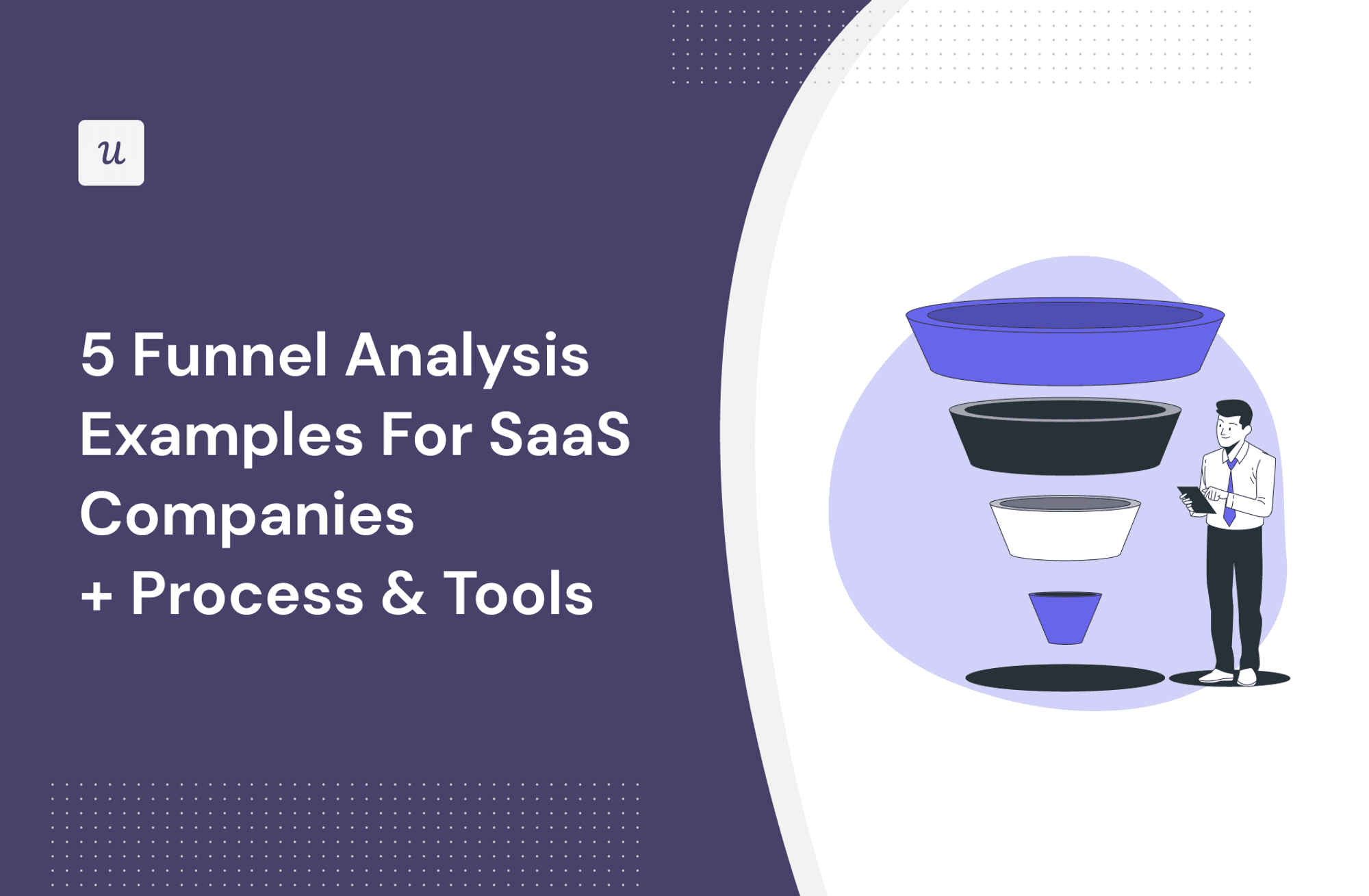
Funnel analysis examples can help product managers find the missing puzzle pieces to improve user journeys.
From marketing funnel analysis to review funnel analysis, this article shows you the most important funnels for SaaS. Discover the critical stages of each funnel and tools that help you gather actionable insights.
Try Userpilot Now
See Why 1,000+ Teams Choose Userpilot

Summary of funnel analysis examples
- Funnel analysis helps map out all the steps website visitors and in-app users take to achieve conversion goals, like signing up for your tool or completing the onboarding process.
Funnel analysis allows you to:
- Measure company performance.
- Create data-driven product roadmaps.
- Identify friction areas.
- Increase revenue growth.
Here’s how to perform conversion funnel analysis for a specific user journey:
- Create your user personas.
- Map out each stage in the customer journey.
- Visualize the journey with a funnel analysis chart.
- Identify drop-off points from the report.
- Couple findings with other reports to drive deeper insights.
Five funnel examples to extract actionable insights:
- Marketing and sales funnel.
- Onboarding process funnel.
- Activation funnel.
- Free trial to paid conversion funnel.
- Review funnel.
Best funnel analysis tools to try
- Userpilot – Best funnel analysis tool for tracking user behavior.
- Google Analytics – Best tool for tracking website conversion funnels.
- Hotjar – Best for qualitative user behavior tracking.
Ready to start tracking user funnels for your in-app user journeys? Book a Userpilot demo to begin.
What’s your biggest challenge with funnel analysis right now?
Which funnel are you most interested in optimizing?
How are you currently analyzing user behavior?
You’re ready to fix your leaky funnel.
Stop guessing and start improving. See powerful funnel analysis examples in action and learn how Userpilot can help you identify and fix drop-off points to boost conversions.
What is funnel analysis?
Funnel analysis is a method for tracking how users progress through each user journey. These range from landing page conversion journeys to in-app onboarding journeys.
This lets product managers and marketers track how users progress through each stage. By visualizing the conversion rate at each step, funnel analysis identifies where users drop off and highlights opportunities for improving the user experience and increasing conversions.
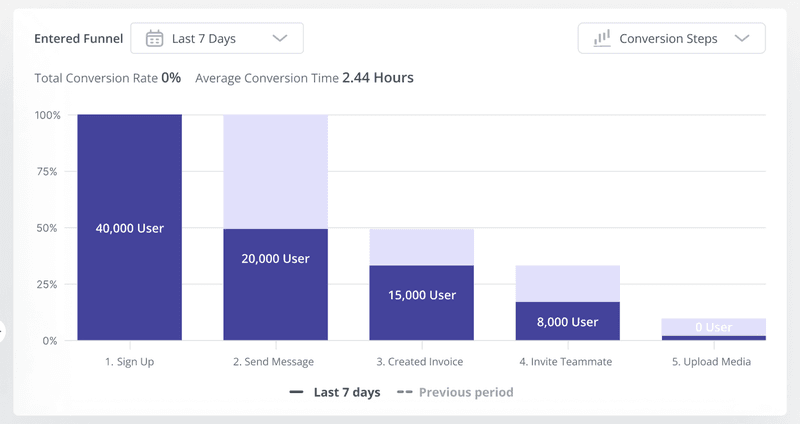
The benefits of conducting funnel analysis
Regular and comprehensive conversion funnel analysis enables you to:
- Measure company performance: By analyzing how users progress through important journey stages, you can track your efforts across marketing, activation, adoption, and retention, and see what you’re doing right.
- Create data-driven product roadmaps: Funnel analysis uncovers areas where users struggle the most. Based on this information, you can prioritize features and updates that improve the user experience.
- Identify friction areas: One of the core advantages of funnel analysis is pinpointing where users drop off. It might be from a confusing sign-up form, slow-loading pages, or a complicated payment process. By identifying these friction points, you can take targeted actions to remove obstacles and create a smoother flow.
- Increase revenue growth: Enhancing user journeys across multiple areas leads to better product experience, increased conversion rates, and more long-term retention.
How to perform funnel analysis for a specific user journey
Follow these simple steps to analyze user journeys and glean actionable insights.
1. Create your user personas
A user persona is a fictional yet realistic representation of your ideal customer. It allows you to closely observe how different user segments interact with your product.
User personas go beyond basic demographics and delve into the motivations, behaviors, and pain points of specific user segments.
When creating a user persona, answer these three questions:
- Who is the user?
- What is their primary goal?
- What are their pain points?
Here’s a simple template you can use.
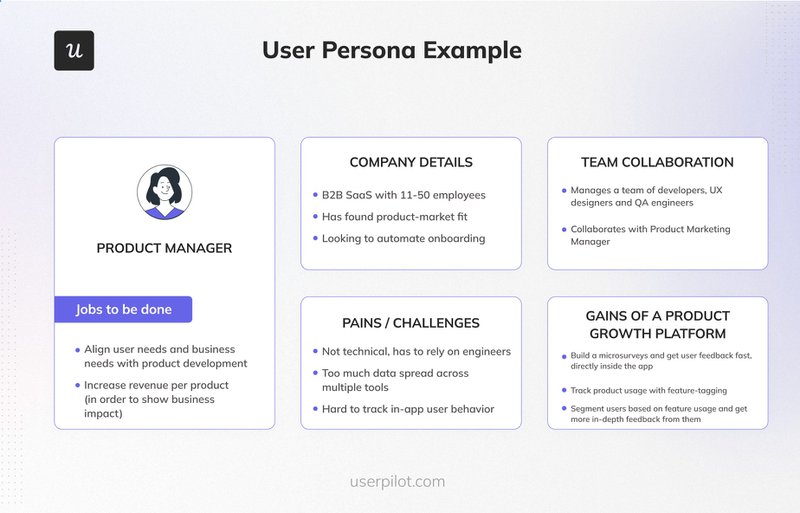
2. Map out each stage in the customer journey
Choose the customer journey you want to analyze, then map every touchpoint, from initial contact to conversion.
For example, if you’re analyzing your onboarding process, highlight every step from when the user sees your first onboarding element to when the onboarding is complete.
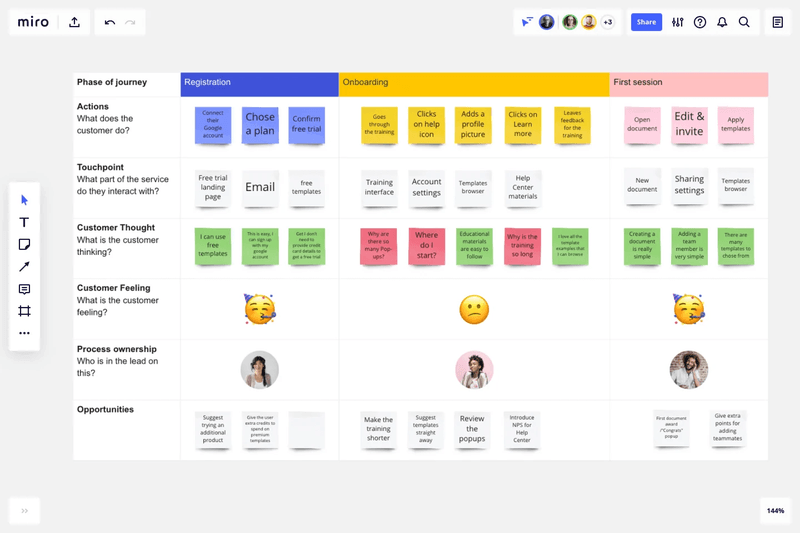
3. Visualize the journey with a funnel analysis chart
Using a product analytics tool such as Userpilot, define the customer journey by adding events in the order that users should complete them.
Then, generate funnel reports showing how many users completed each event. The report should look something like this for easy interpretation.
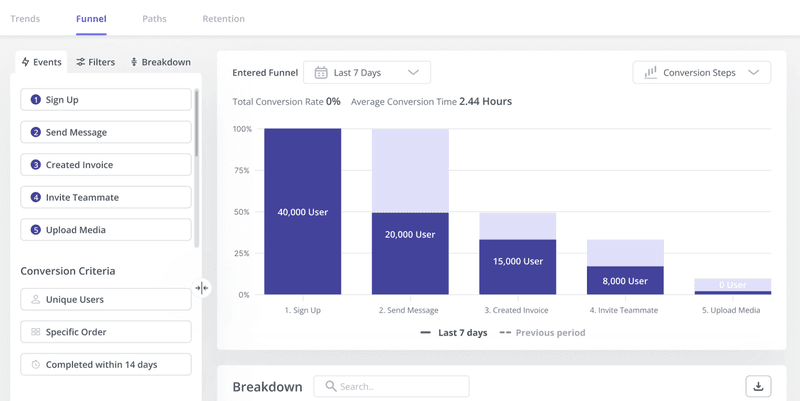
4. Identify drop-off points from the report
Carefully review the funnel analysis chart to pinpoint stages with high drop-off rates.
Identifying these drop-off points is crucial for understanding which parts of the user journey require optimization to reduce friction and enhance user experience.
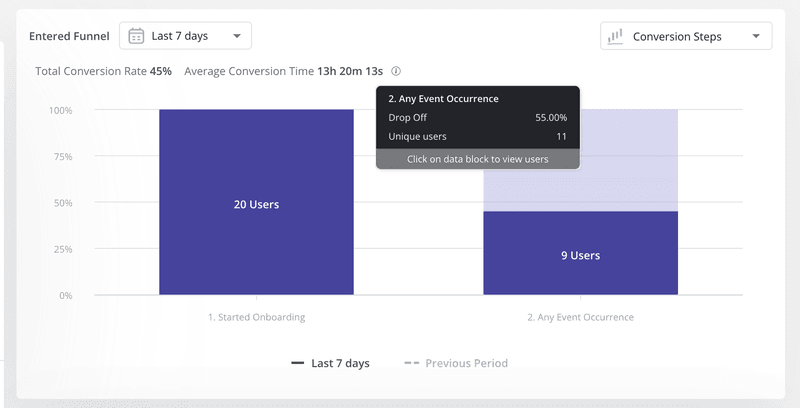
5. Couple findings with other reports to analyze user behavior
Funnel analysis helps point out where the problem lies, but it doesn’t show you what’s causing it.
To get a comprehensive understanding of the reason behind the friction, you’ll need to pair funnel reports with other reporting tools such as feedback surveys, or session recordings (Userpilot’s session recording feature will be released before the end of Q1 2024).
Here’s an example of how pairing with other reports gives you better insights.
Say, your funnel report shows most users leave the onboarding flow before importing their data, but you don’t understand why. By watching session recordings of user interactions, you might see that users struggle to find the import button.
Armed with this additional insight, you can deploy tooltips or other contextual solutions to help users engage better.
5 funnel examples to gain valuable insights
This section shows you five major funnel analyses in SaaS. Read through and see the customer insights they help you gather.
1. Marketing funnel analysis example
Marketing funnels track how website visitors and potential leads discover your product and eventually sign up. Improving this funnel helps you boost new user acquisition while cutting down on your CAC.
Let’s go over the marketing funnel stages and what they represent:
- Awareness stage: At this stage, potential customers recognize a need or problem they have that your product could potentially solve.
- Interest stage: After becoming aware, they start to express interest by looking for more information. They might visit your website, read blog posts, or check review platforms to learn more about what you offer.
- Consideration stage: Here, the potential buyer compares your solution to other options in the market. They’re looking for information to weigh the pros and cons before making a decision. You’ll find buyers in the consideration stage, checking out the pricing and comparison pages on your website.
- Sign-up stage: At this point, potential customers are ready to take some form of action. They subscribe to your newsletter, book a demo, or sign up for a free trial, indicating a direct interest in engaging with your product.
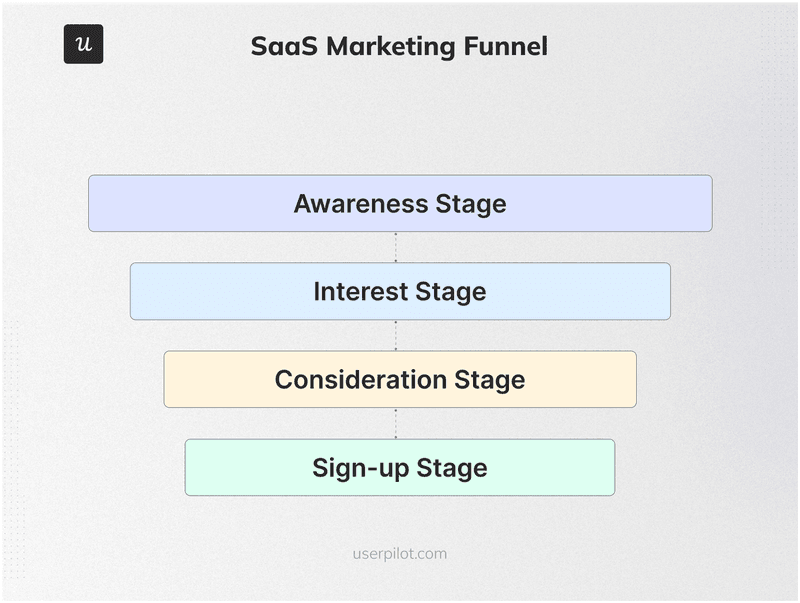
2. Onboarding process funnel analysis example
Onboarding funnels help you monitor how new users move through each step of the onboarding process. By tracking this funnel, you can see where most users feel engaged and where drop-offs happen, allowing you to implement changes and boost product adoption.
You can also track metrics such as time to convert and duration of engagement, enabling you to extract deeper experience insights and lower your time to value.
Here is an example of an onboarding funnel for a project management tool:
- User starts the onboarding flow: The user initiates the onboarding process, often through sign-up or first-time login. This marks the beginning of their guided experience.
- Creates a project: The user follows the first instruction to create a new project. This is where they’ll collaborate with others.
- Adds a user: Next, the onboarding flow explains how to add a new team member.
- Assigns the first task: The last step of the onboarding flow is to create a new task and assign it to a user.
- Finishes onboarding: This is the end of the onboarding where a thank you message may be shown.
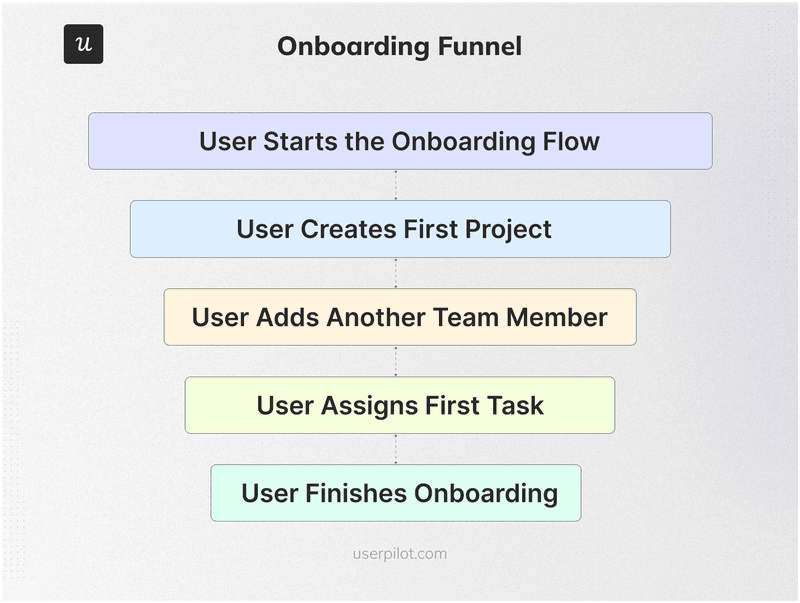
Proper guidance through the onboarding stages helps new users get started with your tool and boosts activations.
Kommunicate, a customer support tool, struggled to get new users to adopt key features. They were able to bring about a 37.5% increase in feature adoption rate and + 3% in expansion MRR within seven months, all with a guided product walkthrough.
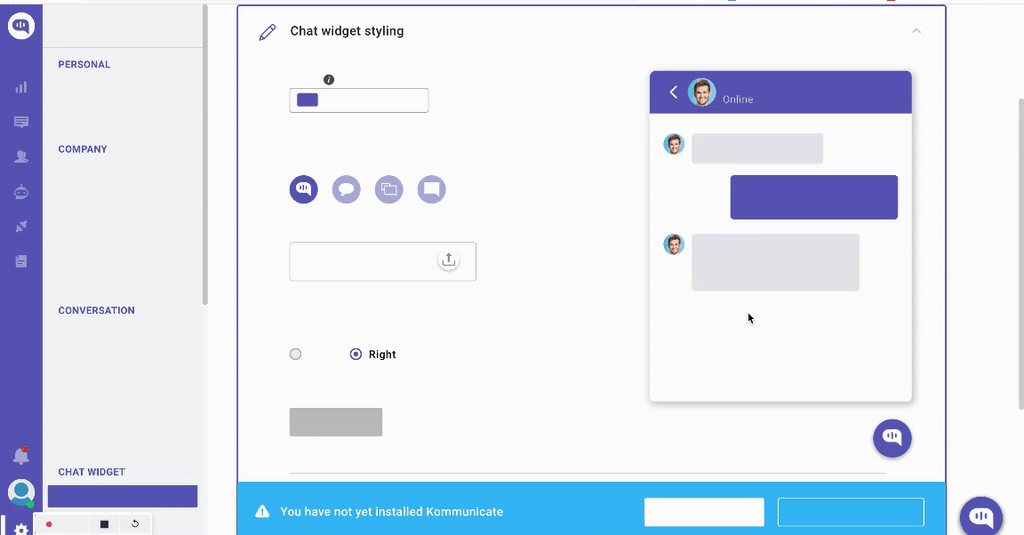
3. Activation funnel analysis example
User activation is when a user experiences the value of your product and decides the tool is right for them.
The activation funnel tracks new users from when they sign up, as they experience the product onboarding and explore the tool, till the point they finally activate. Improving this funnel helps to boost engagement and product adoption.
Activation funnel stages vary because every product is different. However, it begins from the sign-up stage and ends at user activation.
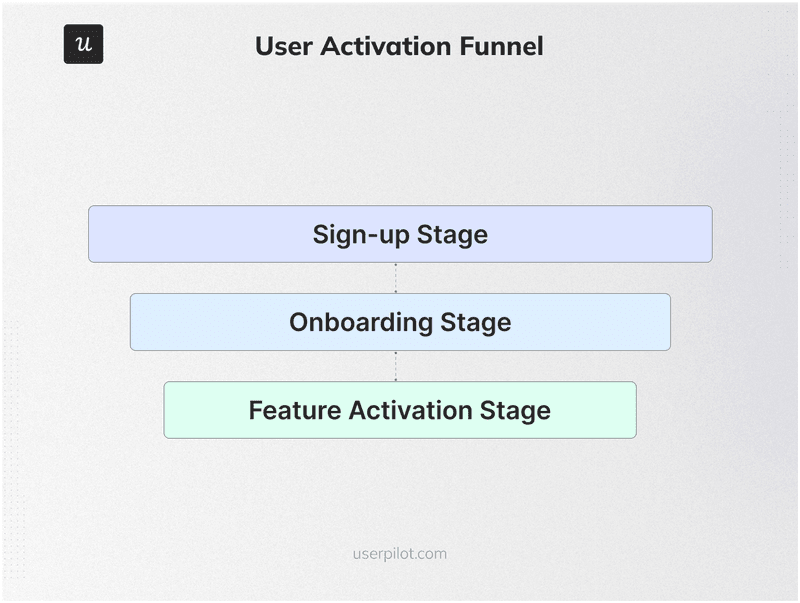
4. Free trial to paid conversion funnel analysis example
The free trial to paid conversion funnel tracks the steps trial users take to convert to paid customers. By understanding how users progress through this funnel, you can spot and address common bottlenecks, increase your conversion rates, and grow revenue.
Track this funnel by monitoring how trial users go from acquisition to adoption and paying customers. However, note that the trial conversion funnel is one of the most porous, with users dropping off at every stage for various reasons.
For example, users drop between acquisition and activation when they come to your tool and realize a value gap. More drop-offs will occur if you don’t have an effective onboarding process that reduces time to value and drives adoption. The solution to all these is to regularly analyze the funnel steps and find insights to help users progress more smoothly.
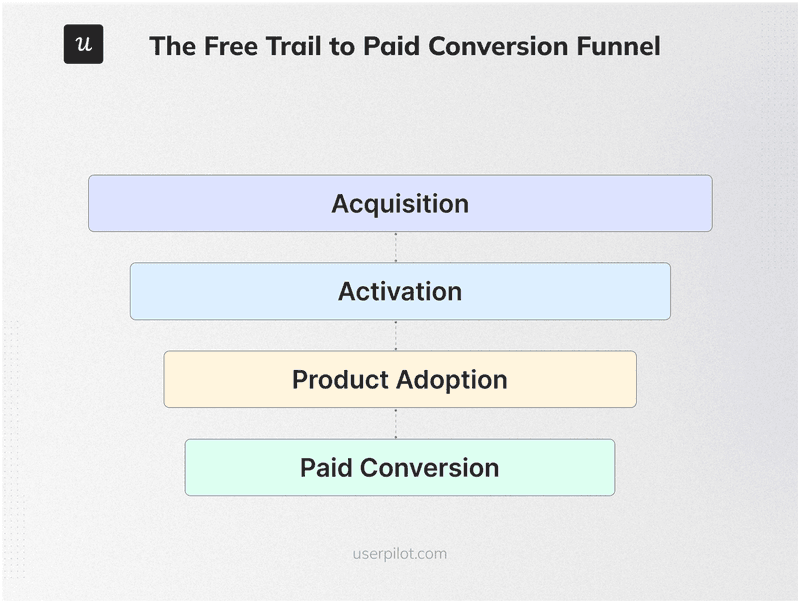
5. Review funnel analysis example
A review funnel is a strategic process designed to guide satisfied customers through the steps of leaving positive reviews on social media, review platforms, or other channels.
Optimizing this funnel helps your brand build a strong online presence and offers social proof, leading to improved customer acquisition.
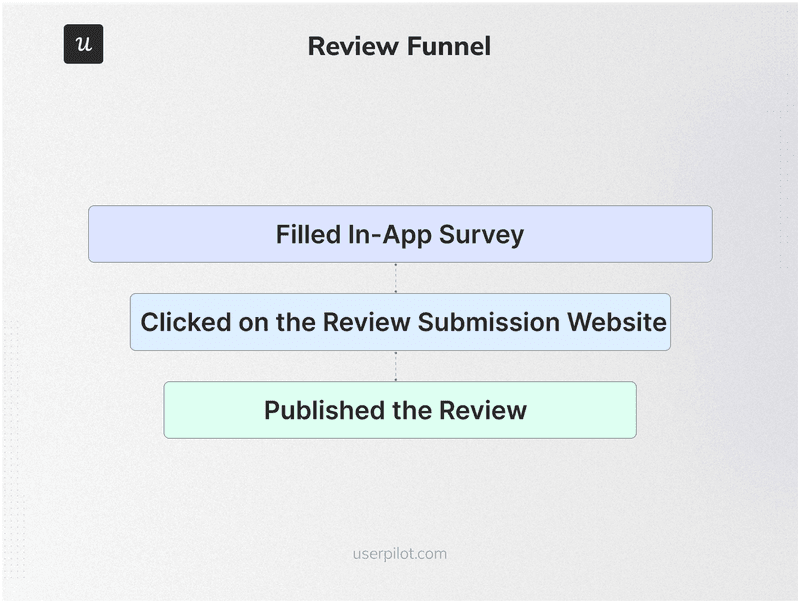
Here’s how a review funnel could work:
- Trigger a Net Promoter Score (NPS) survey in-app, asking users how likely they are to recommend your tool (or feature) on a scale of 0-10.
- Segment the promoters (those who love your tool and score you a 9 or 10). The detractors and passives will drop off here.
- Ask promoters to leave you a review, as in the example below.
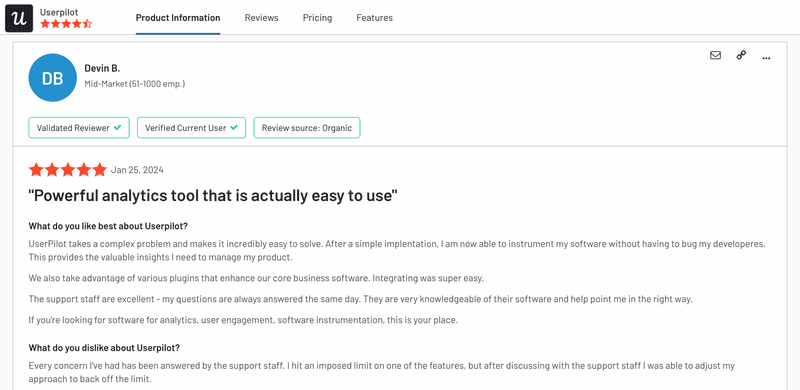
Best funnel analytics tools to try
Specialized tools make it easy to visualize user funnels and spot issues in the customer journey. This section shows you three of the best funnel analytics tools and their features:
Userpilot – Best funnel analysis tool for tracking user behavior
Userpilot is a product growth platform that lets users build in-app engagement flows, track product usage data, and collect customer feedback.
It offers powerful funnel analysis tools you can use to create custom events for all user journeys and track how users move through each event. The robust visualization options make it super easy to view key metrics, interpret funnel reports, and draw insightful conclusions.
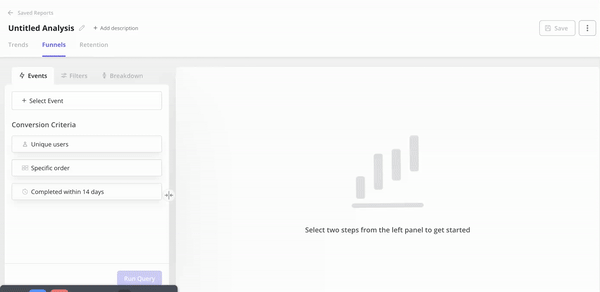
You can also break down your funnel analysis by various user properties such as device type, location, sign-up date, and more.
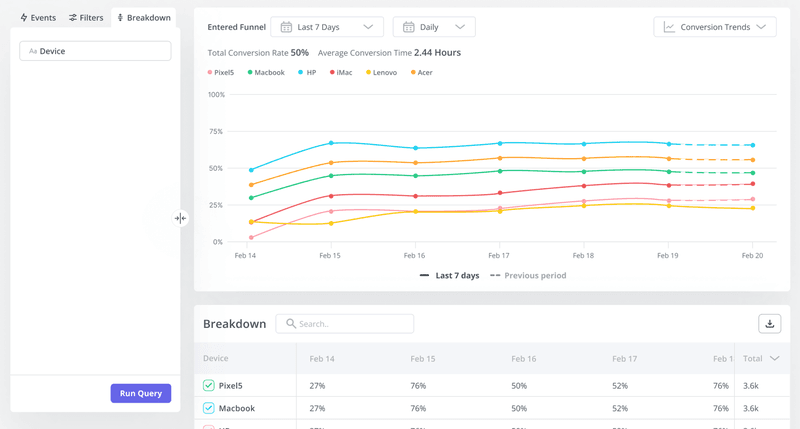
Moreover, Userpilot offers extensive product analytics to give you a better understanding of the user experience. Here’s a quick overview:
- Path analysis: Monitor all the paths users take to reach the final conversion stage.
- Trend analysis: Track changing user behaviors and preferences.
- Feature usage reports: Analyze how users interact with specific features and events.
- Feature engagement dashboard: Monitor key usage metrics and reports in one place.
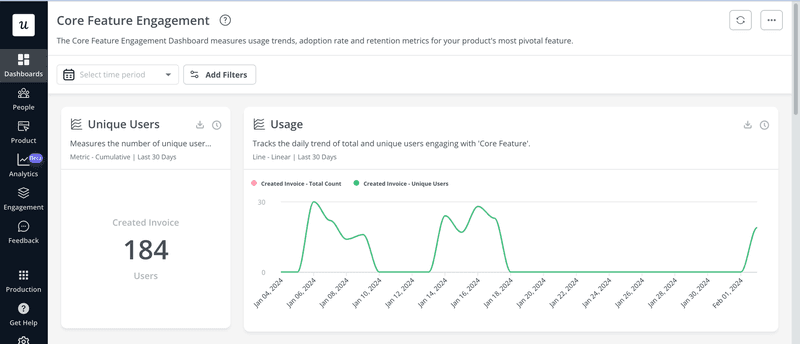
Google Analytics – Best tool for tracking website conversion funnels
Google Analytics is a website analytics platform that tracks and reports user behavior on websites and apps. You can use it to track marketing metrics such as page views, traffic sources, bounce rate, time on site, and conversion rates.
GA also lets you set up goals and create funnel reports to track how users progress through various steps toward conversion. The platform has free and paid plans. The paid plan lets you analyze funnel metrics for complex, enterprise-level marketing efforts.
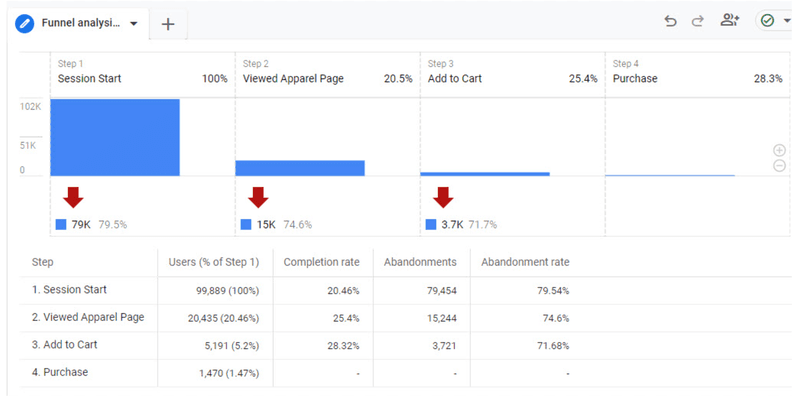
Hotjar – Best for qualitative user behavior tracking
Hotjar specializes in helping companies track user behavior in-app.
Aside from heatmaps, session recording, and user feedback widgets for gathering qualitative data, the tool has a funnel analysis feature that lets you visualize user flow through predefined pages on your website.
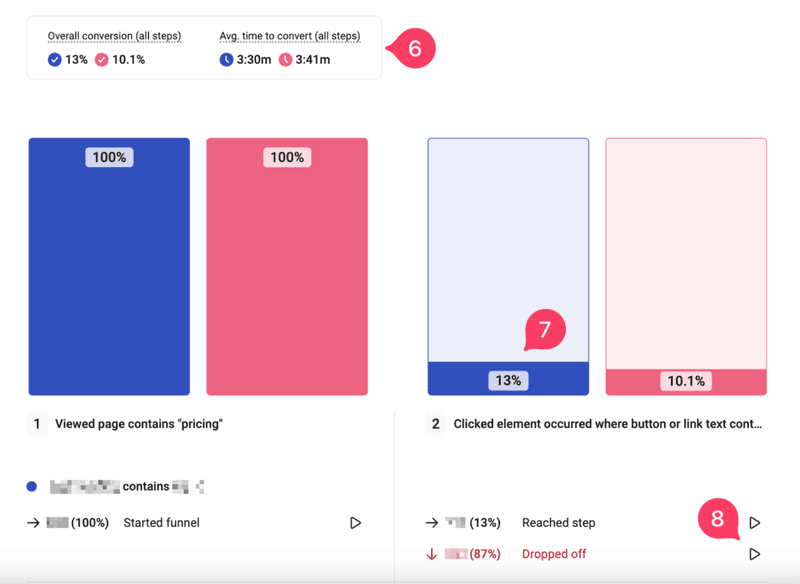
Conclusion
Funnel analysis can be the key to turning your product experience from meh to great. By regularly analyzing your conversion process, you can spot and address friction points to help users enjoy your product more.
Feeling inspired by these funnel analysis examples and ready to start tracking them for your SaaS? Book a demo call with our team and see how Userpilot can help.







